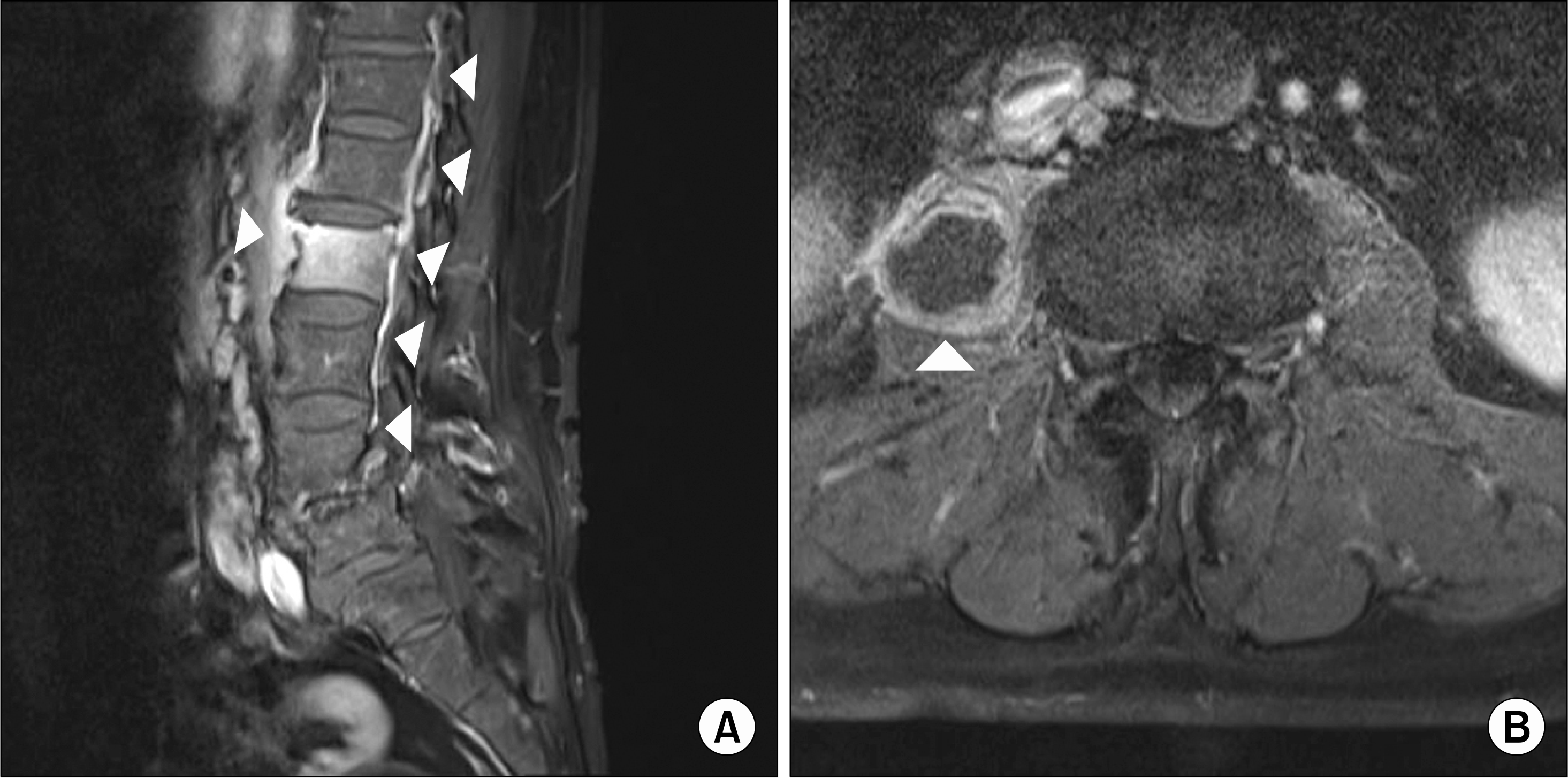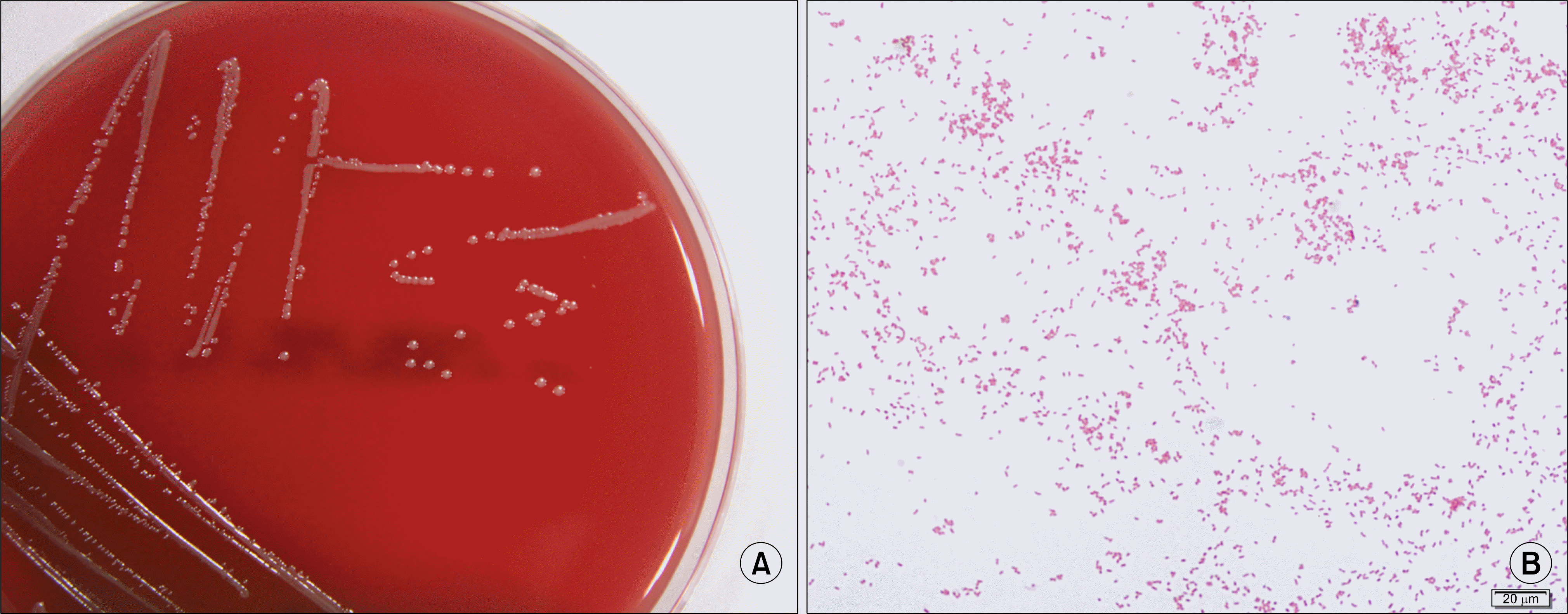초록
Aggregatibacter aphrophilus, a normal component of oral cavity flora, mostly causes infective endocarditis and only rarely causes spondylitis; no spondylitis cases have been previously reported in Korea. We report a case of pyogenic spondylitis due to A. aphrophilus without endocarditis. A 64-year-old man was admitted for back pain lasting 3 weeks. There was severe tenderness on lumbar spines but no fever. Laboratory evaluation showed leukocytosis and ele-vated C-reactive protein. Blood cultures were negative. Magnetic resonance imaging showed psoas abscess and vertebral inflammation. Pus was ob-tained by computerized tomography-guided aspiration from the psoas abscess and inoculated into blood culture bottles. After 5 days of incubation, growth was detected: the isolate was a Gram-negative short rod bacteria identified as A. aphrophilus by the automated system; this was confirmed by 16S ribosomal RNA sequencing. There was no evidence of endocarditis in echocardiography and retinal examination. Back pain persisted despite 8 weeks of antibiotic treatment, so vertebral corpectomy was performed. A. aphrophilus, a rare cause of pyogenic spondylitis, can induce spondylitis without endocarditis. If a patient with pyogenic spondylitis shows negative routine bacterial cultures, fastidious organisms such as A. aphrophilus should be suspected and the blood culture bottles could be used.
Go to : 
REFERENCES
1.N⊘rskov-Lauritsen N., Kilian M. Reclassification of Actinobacillus actinomycetemcomitans, Haemophilus aphrophilus, Haemophilus paraphrophilus and Haemophilus segnis as Aggregatibacter actinomycetemcomitans gen. nov., comb. nov., Aggregatibacter aphrophilus comb. nov. and Aggregatibacter segnis comb. nov., and emended description of Aggregatibacter aphrophilus to include V factor-dependent and V factor-independent isolates. Int J Syst Evol Microbiol. 2006. 56:2135–46.
2.Jang YM., Kee SY., Kim BS., Kim YB., Ahn SY., Choi YH, et al. A case of Haemophilus aphrophilus native valve endocarditis. Korean J Med. 2010. 78:257–60.
3.Huh JH., Bae SY., Kim JS., Lee KN., Lee CK. A case of Haemophilus parainfluenzae endocarditis. Korean J Clin Microbiol. 2009. 12:78–81.
4.Kim CK., Cho I., Park YH., Roh KH., Yong D., Lee K, et al. Isolation of Haemophilus aphrophilus and coagulase-negative staphylococci from the blood of a patient with prosthetic valve endocarditis. Korean J Clin Microbiol. 2006. 9:71–5.
5.Cha CH., Shin HB., Jang S., Kim MK., Kim YS., Song JK, et al. A case of Haemophilus aphrophilus endocarditis. Korean J Clin Microbiol. 2003. 6:172–6.
6.Zbinden R., von Graevenitz A. Actinobacillus, Capnocytophaga, Eikenella, Kingella, Pasteurella, and other fastidious or rarely encountered gram-negative rods. Versalovic J, editor. Manual of Clinical Microbiology. Washington, DC: ASM Press;2011. p. 574–87.
7.Colson P., La Scola B., Champsaur P. Vertebral infections caused by Haemophilus aphrophilus: case report and review. Clin Microbiol Infect. 2001. 7:107–13.
8.Clinical and Laboratory Standards Institute. Interpretive criteria for identification of bacteria and fungi by DNA target sequencing: approved guideline. Document MM18-A. Wayne, PA; Clinical and Laboratory Standards Institute. 2008.
9.Pasqualini L., Mencacci A., Scarponi AM., Leli C., Fabbriciani G., Callarelli L, et al. Cervical spondylodiscitis with spinal epidural abscess caused by Aggregatibacter aphrophilus. J Med Microbiol. 2008. 57(Pt 5):652–5.
10.Huang ST., Lee HC., Lee NY., Liu KH., Ko WC. Clinical characteristics of invasive Haemophilus aphrophilus infections. J Microbiol Immunol Infect. 2005. 38:271–6.
11.Samuel W., Dryden M., Sampson M., Page A., Shepherd H. Spinal abscess of Haemophilus paraphrophilus. A case report. Spine (Phila Pa 1976). 1997. 22:2763–5.
12.Chadwick PR., Malnick H., Ebizie AO. Haemophilus paraphrophilus infection: a pitfall in laboratory diagnosis. J Infect. 1995. 30:67–9.
13.Scerpella EG., Wu S., Oefinger PE. Case report of spinal epidural abscess caused by Haemophilus paraphrophilus. J Clin Microbiol. 1994. 32:563–4.
Go to : 
 | Fig. 1.Sagittal (A) and axial (B) gad-olinium-enhancement T1-weighted ma-gnetic resonance imaging scans of the lumbar spine on hospital admission. Enhancement of endplate of L1, the vertebral body of L2 and the parav-ertebral spaces from L1 to S1 (A, ar-rowheads). A large lesion with low signal intensities and peripheral enh-ancement in the right psoas muscle (B, arrowhead). |
 | Fig. 2.(A) Colonies grown on a blood agar plate after 36 hours of incubation in 5% CO2 at 35 o C. The 1 mm-sized white colonies with no hemolysis are shown. (B) Gram stain microscopy of a colony grown on the blood agar plate. Gram-negative short rods are shown (Gram stain, ×1,000). |
Table 1.
Selected key biochemical reactions of Aggregatibacter aphrophilus and the isolate of this study




 PDF
PDF ePub
ePub Citation
Citation Print
Print


 XML Download
XML Download